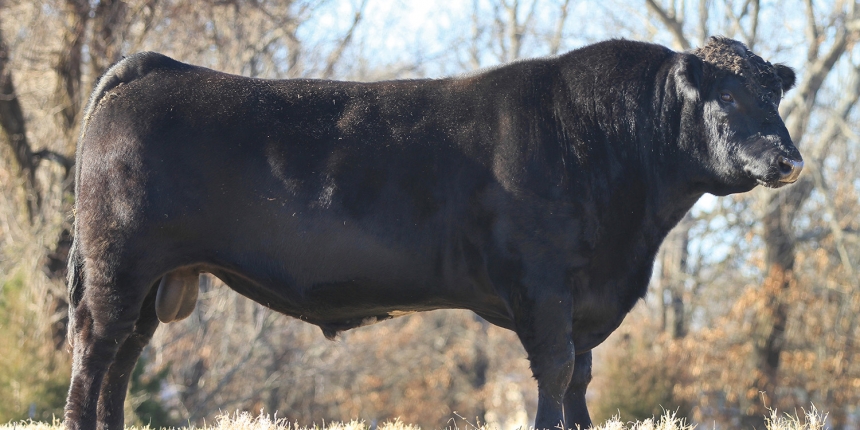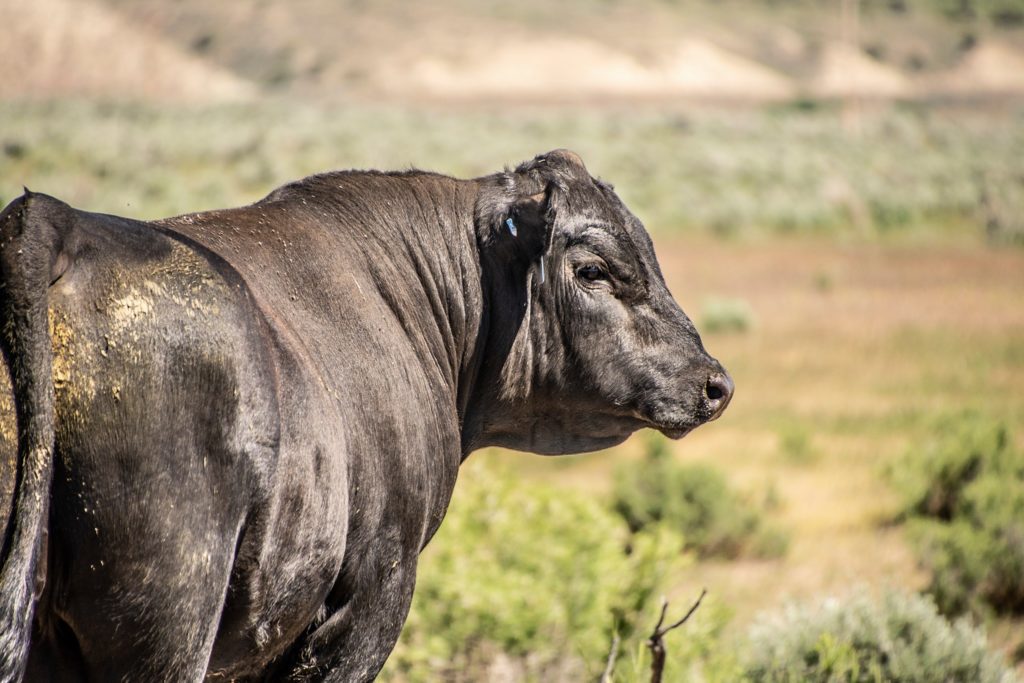Many factors play a role in fertility and breeding ability, so it is important to make sure every bull passes a breeding soundness examination. The standard evaluation looks at 5 things: physical soundness (feet/legs, eyes, etc.), reproductive tract soundness, scrotal circumference, percentage of sperm cells that are normal, with acceptable motility. Even if a bull was fertile last year and sired a lot of calves, he may have a problem this year and should be checked before breeding season. Some problems and injuries are not obvious until the bull is evaluated by a veterinarian.
Ryan Grant, DVM has a veterinary practice that covers northeastern Oklahoma and southwestern and south central Missouri and does more than 1300 breeding soundness exams each year. He says there are two reasons some producers don’t utilize this service. One is the cost, especially if they have several bulls. “Most veterinarians charge $40 to $50 per bull for the exam itself. Many will also test for trichomoniasis which will be an additional cost,” he says. The cost is minor, however, compared with having an infertile or diseased bull (and open or late-calving cows the next year).
If a bull is an unsatisfactory breeder, or will be passing trichomoniasis to your cows, it’s best to know this before the breeding season so you’ll have time to replace him. Grant recommends testing at least 30 days prior to turnout; this gives the producer time to find another bull if necessary.
The second reason some producers don’t have their bulls tested is due to lack of facilities. “When I first started practicing, if someone wanted bulls tested at their place, and their facilities were poor, I would do it. But now I don’t take those risks. It’s important to have a good chute to handle bulls. Most practitioners use an electro-ejaculator to obtain a semen sample. This sends electrical impulses through the accessory sex gland, which causes a significant reaction,” he says. There is some discomfort, and a bull can tear a chute apart if it’s not adequate for restraining him.
“These bulls can destroy a poor chute and hurt the people around them. Now I am picky about where I test bulls and do most of them in a hydraulic chute–either in my clinic or the sale barn’s hydraulic chute, or on-farm if the producer has a hydraulic chute. I rarely test bulls in a manual chute anymore because it’s more difficult to get adequate squeeze on them for proper restraint. Without proper restraint, the bull can lunge around too much, and injure his back. A person has to be careful to not create injury just trying to get the bull collected,” says Grant.
Basics of the BSE
Soundness and physical condition are evaluated. “I like to watch each bull’s movement as he approaches the chute. Once he is in the chute, if we have an assistant to mug him I look at his teeth, and also assess his eyes and overall body condition,” says Grant.
“When I start looking at the reproductive organs I feel his sheath and make sure there are no strictures or adhesions, hematomas or swellings. I work back to the scrotum and palpate both testicles to make sure they have normal consistency and that I can feel a good epididymis. I also check scrotal circumference, especially on bulls that will be siring replacement heifers.” Larger testicles usually indicate greater fertility (more storage space for sperm) and fertility in the bull/scrotal circumference seems to have a correlation with fertility in that bull’s daughters.
A circumference of 30 to 31 centimeters would be bare minimum for a 15-month-old bull, and older bulls should have larger testicles. “Keeping records on scrotal circumference also allows me to go back to last year’s records and I can know if the bull is a lot bigger (or smaller) than he was the year before,” says Grant. A young bull with small testicles will often have more adequate circumference the next year. Sometimes an older bull will start to lose circumference as he becomes older and less fertile.
“Then I check the bull rectally because this allows me to feel the accessory sex glands, the ampulla and the prostate—to make sure that both lobes of the prostate are symmetrical. I also check the seminal vesicles as much as possible to make sure there’s no seminal vesiculitis,” he says.
After that examination he inserts the probe rectally and begins collecting a semen sample. The goal is to have the bull extend enough to also examine the penis, but not all bulls will extend. There are some problems that may not be detected (such as hair rings or penile warts) unless the penis can be visualized. Most bulls will extend, but Grant says about 15 to 20% (especially older bulls) try to resist and fight the probe. If they’ve been through this before, they may not cooperate.
“Once we get the bull to ejaculate we have a semen sample to look at under the microscope to assess sperm motility (percentage of cells that are moving),” he says. A stain is used on the slide to check morphology and determine the percentage of sperm that are normal or abnormal—assessing form and structure, shape of the sperm heads, size and appearance. The bull is then graded on motility and morphology.
If the bull has acceptable motility and morphology, Grant takes a sample of material from deep inside the sheath, to send to a lab to check for trichomoniasis. “We record all identification numbers for the bull and put an official ID number in his ear, and that number goes on the pouch we send to the lab, and give him an ear tag for ID.”
After the examination, each bull is given a score of satisfactory, unsatisfactory or deferred. A young bull may be deferred—to be checked again later. “If a young bull is too immature to pass his test, we may give him more time. He may have been pushed hard to get him bigger, but he may still be very young and not mature enough to successfully breed cows. We retest a lot of young bulls,” says Grant.
“I may also retest a bull if I see a lot of white blood cells in the sample. A young bull with white blood cells in the ejaculate will often clear up the infection, even without medication, and be fine. An older bull, however, that has white blood cells or signs of vesiculitis, often still has the infection when we retest him later. Treatment generally doesn’t make much difference. A young bull may just need time, but an old bull may not clear up, and he’s generally finished as a breeding bull.”
Monitor Bulls During Breeding Season
“A breeding soundness exam (BSE) is a great tool, but just one piece of the picture. Some problems (like trich) won’t show up on a typical exam, so producers need to pay attention to what’s happening in the herd. If some cows continue to cycle or some abort, there may be a bull problem. Just because a bull passes his exam, this is no guarantee that everything is ok,” says Grant. That bull may be fertile, and breed all his cows, but if he carries something like trich and passes it to the cows, there will be problems. Or, he may not be breeding the cows.
“I’ve seen bulls that had good structure, good sperm motility—and everything seemed fine—but very little desire to do the job. He may have poor libido, or might be more interested in fighting other bulls than breeding cows. Just because a bull passes a BSE doesn’t necessarily mean he will do the job. Producers need to pay attention and know what’s going on,” says Grant. If a bull has some pain issues, or is intimidated by more dominant bulls in the herd, he may be reluctant to try to breed cows.
Bulls also get injured when fighting or breeding cows. “The producer should be observant and watch for penile hematomas or any swelling or abnormality in the sheath or testicles. Some problems are not apparent until you watch the bull actually breed a cow or try to breed. Some bulls just don’t penetrate, for instance,” he explains.
Testing For Trichomoniasis
This serious reproductive disease causes early pregnancy loss in cows, and is spread from cow to cow by the bull. Once infected, the bull generally remains infected; the protozoal organisms hide in the deep folds of the sheath. To get a sample for testing, the veterinarian takes a scraping from inside the prepuce. “The organism lives toward the back of the prepuce where there are more folds. We take a swab from that area, put it in a growth media, and send it to a lab for DNA testing,” says Grant.
“This is a difficult organism to detect with just one test. If we have a problem herd (with many cows returning to heat and several open cows at the end of the breeding season) this is one of the first diseases we suspect, and we test all the bulls. Even if I get a negative result on a bull from that herd, I will re-test him,” says Grant.
It may take 2 or even 3 tests to determine whether a bull is actually negative for trich. “We use a PCR test that looks for the DNA of that organism, but as it replicates it goes through peaks and valleys and sometimes you’ll get a false negative on the initial test. The older test (checking samples under a microscope for the actual organism) required 3 tests—several weeks apart—to make sure a bull was negative. The newer PCR test checks for the actual DNA, but can still occasionally come up negative on an infected bull,” says.
A single test will catch most of them, but not all, so it’s sometimes good to repeat the test,” he says. On rare occasion it may take 3 tests to conclusively prove that a bull is negative.
Source: Heather Smith Thomas. American Cattlemen 1/27/2021








